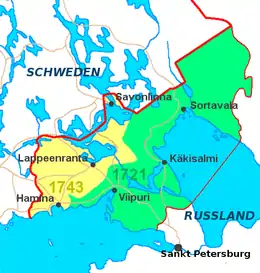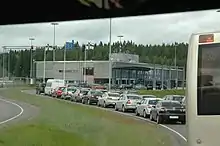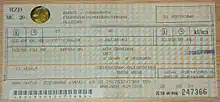Finland–Russia border
The international border between Finland and Russia is 1,340 km (830 mi) long and runs approximately north to south,[1] mostly through taiga forests and sparsely populated rural areas. It does not follow any natural landmarks, such as rivers.[2] It is also an external border of the European Union and NATO.
| Finland–Russia border | |
|---|---|
 Finnish (blue–white) and Russian (red–green) boundary marks at the easternmost point of Finland, in Ilomantsi | |
| Characteristics | |
| Entities | |
| Length | 1,340 km (833 mi) |
| History | |
| Established | 6 December 1917 Finnish Declaration of Independence |
| Current shape | 10 February, 1947 Paris Peace Treaties |
| Treaties | |

It is patrolled by the Finnish Border Guard and the Border Guard Service of Russia, who also enforce border zones extending 0.1–3 km (0.06–2 mi) on the Finnish side[3] and at least 7.5 km (4.7 mi) of on the Russian side. A permit is required for entry to these border zones. Electronic surveillance on the Finnish side is concentrated most heavily on the southernmost 200 kilometers (125 miles).[4] In addition, the Finnish Border Guard conducts irregularly scheduled dog patrols multiple times daily to catch illegal entries into the border zone. In the Arctic region, Russia maintains its 500-year-old border patrol, with plans to upgrade Soviet-era technologies to reduce costs and to improve efficiency by 2020.
The border can be crossed only at official checkpoints, and at least one visa is required for most people. Major border checkpoints are found in Vaalimaa and Nuijamaa, where customs services on both sides inspect and levy fees on imported goods.
The northern endpoint of the border between Norway, Finland, and Russia forms a tripoint marked by Treriksrøysa, a stone cairn near Muotkavaara (69°03′06″N 28°55′45″E). On the south, the boundary is on the shore of the Gulf of Finland, in which there is a maritime boundary between the respective territorial waters, terminating in a narrow strip of international waters between Finnish and Estonian territorial waters.[5][6]
History

Sweden–Russia border
The first treaty concerning the border was signed in Nöteborg in 1323 between Sweden (to which Finland belonged) and the Novgorod Republic. The Treaty of Teusina in 1595 moved the border eastward. As a result of the Ingrian War and the resulting Treaty of Stolbovo (1617), Sweden gained a large tract of land through the acquisition of the Nöteborg fortress, Kexholm and its large province, southwest Karelia and the province of Ingria. The Treaty of Nystad in 1721 and the Treaty of Åbo in 1743 moved the border westward.
Generally, the native populations on both sides of the border were ethnically Finnish. However, the border region was marked by religious differences, with the Russian side being predominantly Orthodox, while the Swedish side was initially Catholic, and later, Lutheran Protestant. After the peace of Stolbovo in 1617, the Orthodox population faced persecution and many fled to the Russian side or converted to Lutheranism. The displaced population was largely replaced by immigrants from Finland, most of whom were Savonians who spoke Finnish instead of the closely related Karelian.
Internal Russian border
After the Finnish War, the Treaty of Fredrikshamn transferred Finland from Sweden to the Russian Empire, with the territory becoming a Russian possession known as the Grand Duchy of Finland. In 1812, the Finnish–Russian border reverted to its pre-1721 location, granting the Grand Duchy so-called "Old Finland" territories previously held by Sweden.
Finland–Soviet-Russia border

In the period following Finland's 1917 independence declaration, during the Finnish Civil War and Russian Civil War, Finnish activists often crossed the border into Soviet territory in order to fight in the "heimosodat" wars surrounding Finnish ethnic self-determination and possible annexation into Finland. This ended in 1920 when the Russian–Finnish Treaty of Tartu in 1920 defined Finland as an independent country and established the border between the two countries. Despite this, Finnish fighters took part in the East Karelian uprising and Soviet–Finnish conflict of 1921–22. In 1922, the Finnish government closed the border to volunteers and food and munitions shipments.
Changes to borders with World War II

In 1939, the Soviet Union invaded Finland in the Winter War, leading to the signing of the Moscow Peace Treaty the following year. The treaty had Finland cede several border areas to the USSR.
The naval border was established in 1940 and more accurately defined in 1965.
Between 1940 and 1941, the Soviet Union rented Hanko Peninsula as a military base, thereby creating an additional border crossing leading to the exclave.
After the Continuation War (1941–44), the land border was demarcated in the Treaty of Paris (1947). As a result, approximately half of Finnish Karelia (including Finland's fourth-largest city Vyborg), parts of Salla, and all of Petsamo were ceded to the Soviet Union. The new border cut through what was previously Finnish territory, severing many rail lines and isolating many Karelian towns from Finland. The Soviet Union demanded the territories be emptied, and Finns were subsequently evacuated from the area and resettled in Finland. The areas that they left were then settled by Soviet immigrants.
In the Moscow Armistice signed in 1944 between Finland, the Soviet Union and the United Kingdom, a small peninsula towards the Gulf of Finland, Porkkala, was rented to the Soviet Union as a military base. This created in effect a southern border crossing to the Soviet exclave. Border crossings were in Luoma (checkpoint) and Tähtelä. In 1947, Finnish trains were allowed to pass through the base, but the passenger car windows were blinded and the locomotives replaced while crossing through. Porkkala was returned to the Finnish government in 1956.
Soviet–Finnish border during the Cold War

During the Cold War, the border constituted part of the perimeter of the Iron Curtain. Crossing the border was not possible for much of its length. Only a very limited number of border crossing points existed, and the Soviet government permitted only escorted trips to select cities; border zones were off limits to tourists.[7] There was little contact between cities that were relatively close to each other on opposite sides of the border, such as Imatra and Svetogorsk.
The Soviet side maintained extensive electronic systems and patrols to prevent illegal crossings. Soviet border surveillance began at a great distance from the actual border, and was as extensive as elsewhere along the Iron Curtain. The first surveillance systems were installed in railway stations in cities, where the militsiya monitored potentially suspicious traffic. The border zone began at 120 kilometres (75 mi) from the border. A special permit was required for entry, and the first line of control was equipped with electronic alarms. At 60 kilometres (37 mi), there was a raked sand strip (to detect footprints) and a thin alarmed tripwire. At 20 kilometres (12 mi), there was a 3 metres (9.8 ft) tall barbed wire fence, with a top that curved inwards towards their own territory to prevent Soviet citizens from leaving. The fence had an electronic alarm system. However, it was not protected underground and tunnelling under it was possible. On the Finnish side, there was a border zone where entry was allowed only with a permit, and a "reindeer fence" closer to the border. Finally, at the international border, there was a border vista. Since Finland was a neutral country for most of the Cold War, they did not protect illegal border crossers and instead returned them to the Soviet authorities if captured. As a result, illegal border crossers had to arrive in a third country, for example Sweden, in order to defect to the West.[7]
Both states verified the inviolability of borders and territorial integrity in the first Conference on Security and Co-operation in Europe in 1975.
Traffic
.jpg.webp)
Finland issues the most Schengen visas to Russians out of all the countries in the Schengen area.[8]
In 2015, 9.1 million individuals crossed the border, half of which went through Vaalimaa and Nuijamaa.[9]
Traffic across the border was interrupted during the COVID-19 pandemic.
In 2023, Finland stopped issuing new tourist visas to Russians due to the Russo-Ukrainian War, and downgraded their travel advisory for Russia to "avoid all travel".[10] New Finnish visas can only be issued for travelers in certain categories, such as people with family in Finland or people who currently reside or work in Finland.[11] As a result, border traffic has not yet returned to pre-COVID-19 levels, though it still remains significant. By July 2023, there had been 973,337 border crossings, most of which occurred over land borders.[12] Most people crossing the border had multiple-entry visas issued before 2019 or Schengen visas issued by other member states. Entering Finland via Norway still remains legal, as Norway does not restrict tourist visas.[13]
On September 16, 2023, Finland banned vehicles with Russian license plates from entering their territory, in accordance with a decision by the European Union.[14]
Incidents



On 26 November 1939, the Soviet Union carried out a false flag attack on Finland, shelling the village of Mainila, located on the Soviet side of the Finland–Russia border, and then accusing Finland of being the aggressor. The Soviets used this as a pretext to instigate the Winter War, which began four days later on November 30.
According to a Russian media report, Finland closed its Raja-Jooseppi border crossing with Russia, a counterpart to the Russian Lotta (checkpoint) border post, on 4 December 2015, an hour and a half before the day's scheduled closing time and thus prevented fifteen people from crossing the border. According to the same source, some Finnish border officials confirmed that Raja-Jooseppi had closed early that day while a spokesman for the same department said the checkpoint closed at its regular time of 21:00.
On 27 December 2015, Finland blocked access to people crossing the border by bicycle at Raja-Jooseppi and Salla. According to the Finnish Border Guard, this measure was to limit illegal immigration and ensure safety on slippery roads.[15] The Finnish Border Guard stated that organized traffickers were making their clients cross the border by bike in order to avoid being captured on the Finnish side and prosecuted for organizing illegal immigration, which is a felony in Finnish law. In response to the prohibition, asylum seekers started to cross the border by car, often using dilapidated cars purchased in Russia.[16][17]
On 23 January 2016, Finnish Foreign Minister Timo Soini, member of the Finns Party, visited the Salla border crossing, where he talked about human smuggling across the border and claimed that there was "probably" an entity on the Russian side that was organizing the inflow of immigrants.[18] Furthermore, a representative of the Finns Party noted that the influx of immigrants was causing disturbances for Finns driving to the Russian side to purchase petrol, as the border was being held up by lengthy immigration proceedings.[19]
In March 2016, Finland and Russia temporarily closed the Raja-Jooseppi and Salla border crossings to third country nationals. Only Finnish, Russian and Belarusian citizens were allowed to use these crossings for a period of six months.[20] The measure was later removed.
Finland began constructing a border barrier in 2023 due to the Russo-Ukrainian War.[21]
List of border checkpoints


Regular border checkpoints, ordered from north to south, are as follows:[22]
- Raja-Jooseppi / Lotta (road 91 / P11 / 47А-059)
- Salla (road 82)
- Kuusamo border station (road 866 / A136)
- Vartius (road 89)
- Vartius (Kontiomäki–Kostomuksha railway, freight only)
- Niirala (Tohmajärvi) / Vyartsilya (road 9 / A130)
- Imatra (road 62 / A124)
- Nuijamaa (road 13 / A127)
- Nuijamaa (Saimaa Canal)
- Vainikkala (Riihimäki – Saint Petersburg Railway, passenger and freight trains, the only rail crossing used in 2015[9])
- Vaalimaa/Torfyanovka (road E18 / 7 / M10)
In addition, there are provisional border crossing points:
- Haapovaara
- Inari
- Karttimo
- Kurvinen
- Leminaho
- Parikkala
- Ruhovaara
- Imatra railway crossing point (Imatra–Kamennogorsk railway, freight only)
Passport stamps
The following are Finnish ink passport stamps issued at the Finnish–Russian border.
 Passport entry stamp from the Finnish border checkpoint at Imatra
Passport entry stamp from the Finnish border checkpoint at Imatra Passport exit stamp from the Finnish border checkpoint at Imatra
Passport exit stamp from the Finnish border checkpoint at Imatra Passport entry stamp from the Finnish border checkpoint at Nuijamaa
Passport entry stamp from the Finnish border checkpoint at Nuijamaa Passport exit stamp from the Finnish border checkpoint at Vaalimaa
Passport exit stamp from the Finnish border checkpoint at Vaalimaa Passport exit stamp (old style) from the Finnish border checkpoint at Vaalimaa
Passport exit stamp (old style) from the Finnish border checkpoint at Vaalimaa.jpg.webp) Passport exit stamp issued on the train in Vainikkala
Passport exit stamp issued on the train in Vainikkala Passport entry stamp (new and old styles) issued on the train in Vainikkala
Passport entry stamp (new and old styles) issued on the train in Vainikkala
References
- Grenfell, Julian; Jopling, Thomas Michael (2008). FRONTEX: the EU external borders agency, 9th report of session 2007-08. House of Lords Stationery Office. p. 13. ISBN 978-0-1040-1232-1.
- "Archived copy" (PDF). Archived from the original (PDF) on September 27, 2013. Retrieved November 29, 2010.
{{cite web}}: CS1 maint: archived copy as title (link) - "Rajavyöhyke - Rajavartiolaitos". raja.fi. Archived from the original on July 24, 2018. Retrieved January 11, 2013.
- "Electronic surveillance grows at Russian border as border guard strength is cut". HELSINGIN SANOMAT INTERNATIONAL EDITION - HOME. October 6, 2009. Retrieved January 14, 2014.
- Svein Askheim. "Treriksrøysa". Store norske leksikon. Retrieved October 1, 2016.
- "Muotkavaara - lines in the wilderness". by-the-borderline.com. Archived from the original on October 31, 2016. Retrieved October 1, 2016.
- Timo Laine. Torakoita ja panssarivaunuja - Silminnäkijänä hajoavassa neuvostoimperiumissa. Tammi, Helsinki, 2014.
- "Barentsobserver". Barentsobserver.
- "Rajavartiolaitos lukuina - Rajavartiolaitos". raja.fi. Archived from the original on August 12, 2018. Retrieved March 28, 2016.
- https://um.fi/matkustustiedote/-/c/RU
- https://raja.fi/maahantulon-rajoitukset
- https://raja.fi/-/katsaus-kaakkois-suomen-rajavartioston-toimintaan-kesakuussa-2023
- https://yle.fi/a/74-20046236
- "Finland joins Baltic neighbors in banning Russian-registered cars from entering their territory". AP News. September 15, 2023. Retrieved September 15, 2023.
- "Finland prohibits crossing border with Russia on bikes - media".
- "Rajavartiosto: Emme yrittäneetkään peitellä pyöräkiellon oikeaa pääsyytä – "Kyllä harmittaa"". December 29, 2015.
- "Uusi ilmiö itärajalla: Turvapaikanhakijoiden "romuautoralli" alkoi?". December 29, 2015.
- "Soini turvapaikanhakijoiden määrästä Venäjän rajalla: "On ilmiselvää, että toiminta on johdettua"". January 23, 2016.
- "Turvapaikanhakijoiden määrää ihmettelevät sallalaiset tapasivat Timo Soinin – "Tilanne ei ole tyydyttävä"". January 23, 2016.
- "Finland and Russia agree on temporary border restrictions". Reuters. March 22, 2016.
- "Finland starts construction of Russia border fence". February 28, 2023 – via www.bbc.co.uk.
- "Opening hours for border crossing points - The Finnish Border Guard". raja.fi. Archived from the original on March 24, 2018. Retrieved July 12, 2018.
External links
 Media related to Finland-Russia border at Wikimedia Commons
Media related to Finland-Russia border at Wikimedia Commons- The Finnish Border Guard, Border Surveillance Archived June 24, 2018, at the Wayback Machine